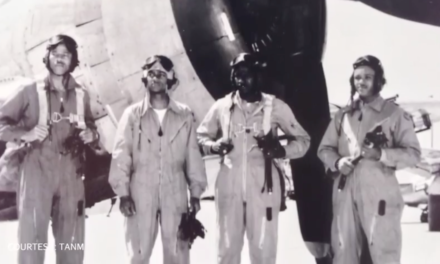It was around the 1930s when gospel music first formed, but how did spiritual music transform from hymns to the contemporary music genre we know today? “American Black Journal” continues its “Black Church in Detroit” series with a look at the history of gospel music and its intersection with the blues.
RELATED: View American Black Journal’s gospel music performance archives!
“You had these, sort of, blues musicians, who were looking at how the vitality was slipping out of sacred music, and they combined the blues with the sacred, and that produced gospel,” Baptist pastor and blues musician Rev. Robert Jones, Sr. said.
Host Stephen Henderson sits down with Rev. Jones to explore the connection between the blues and gospel music — the sacred and the secular, and their symbiotic relationship. Plus, they discuss gospel music’s roots in the African American community then and today.
Full Transcripts:
Stephen Henderson: I’m one of the people who listens to popular music all the time and delights in the idea that, in so many songs written by so many artists, I can hear the church, right? I can hear gospel music in Prince. I could hear it, of course, in Aretha. I can hear it in Demi Lovato or Chance the Rapper. It really is part of American music, this history of gospel. But nowhere do you hear more, of course, than in the blues. And the connection between those two is really something special.
Rev. Robert Jones, Sr. Baptist Pastor & Blues Musician: Right. Well, absolutely, Stephen. I mean, when you think about American music, if you were to come up with the metaphor of a tree, that all of these different styles that you just mentioned are the branches and the trunk is the blues. But even deeper in the ground would be the roots, and the roots, that’s the spiritual. So, not only do you— because you can hear, you know, you can hear it in Demi Lovato, you can hear it in, you know, just name whoever, because it’s all sort of rooted in the black spiritual and then comes up through the blues and branches out through everything else.
Stephen Henderson: So as a reverend and a musician, talk about how you navigate those connections and how they kind of spill over, I guess, from one line of work into the other.
Rev. Robert Jones, Sr.: Well, I was really blessed. I’m a native Detroiter, but I was blessed to have this grandmother from southern Alabama, from Conecuh County, Alabama, who loved many, many kinds of music. So, aside from going to and growing up in the black church, she had no problem with putting some Muddy Waters, and Lightnin’ Hopkins, or B.B. King on the Magnavox and entertaining the entire block.
So, I grew up with like both of those influences and I really feel fortunate that if I had just been a church kid, I may not have been able to make the connection with the blues. And if I’d just been sort of a kid who listened to nothing but blues, I probably wouldn’t hear that. But being this hybrid kid allows me to view both of those kinds of music, in a sense, without prejudice, if that makes sense. So, I can see the connections, and I’ve really been blessed by the connections between both the sacred and the secular.
Stephen Henderson: Yeah. So, you know, the blues is about people expressing pain and sadness through music. And gospel is usually about healing and hope. Those two things would seem to be at odds in some ways. I’ve always felt like, though, there is a connection between the messages as well as the music itself.
Rev. Robert Jones, Sr.: Definitely. Something happens with the spiritual, which is the music that came out of slavery, which was heavy, which was about, you know, getting heaven when you die or suffering or, you know, being resilient and enduring. And then, the blues was kind of like about the idea of not suffering on the plantation but hopping the train and getting away from all of that stuff.
And then, in like around 1930, they melded into this music called gospel. You had these sorts of blues musicians who were looking at how the vitality was slipping out of sacred music, and they combined the blues with the sacred, and that produced gospel. Which you rightly identified as being joyous music, right, It’s the good news.
Rev. Robert Jones, Sr.: But there is no joy without some pain, right? Weeping endures for a night, but joy comes in the morning. So, you have both of those elements mixed in and I think the sacred and the secular really grew up right next to each other. And if your socialization was too steady, you know, be steady, to raise a family, to endure the hardships that you were given, you know, folks pushed you toward the sacred.
But if your inclination was, I’m going to escape from this situation I’m in and I’m going enjoy some life while I’m here, your inclination was toward the blues. But strangely enough, they always have this symbiotic relationship. The greatest gospel singers tend to come out of the blues and the greatest instrumentalists come out; or was that the other way around? The greatest instrumentalists come out of the blues and the greatest singers come out of the church.
Stephen Henderson: Yeah. So, if you think about both gospel and blues, you know, they’ve had time periods where they were more popular than they are right now. And I guess some people might say that they are becoming more and more lost art forms, especially as people leave the church or don’t react or interact with the church the same way they used to. And blues is not as prevalent on the airwaves or anywhere as it used to be. How do you feel about that?
Rev. Robert Jones, Sr.: I think these are foundational forms and they keep reinventing themselves. They find a way to push through because they don’t go away. I mean, chances are if you’re a young singer, the first place that somebody told you that you could sing was in church, right? So, I was having a conversation with a young lady the other day at the Henry Ford Museum, and she was amazed that the new Elvis movie, which of course, has to feature a lot of blues, has a cover of a tune done by Big Mama Thornton called, “Ain’t Nothin But a Hound Dog“, but it is re-defined by Doja Cat. So, it just– It doesn’t go away, it just sort of morphs into something else. And the difficulty is sometimes finding the strand, you know, finding why Ludacris has Lead Belly’s, “Pick a Bale Cotton” in a song called, “Rosa Parks“.
Stephen Henderson: Right.
Rev. Robert Jones, Sr.: You know, how does that work?
Stephen Henderson: That’s right. I also want to talk about the fact that these are uniquely African American art forms. And they remind us, I think, just when you were talking about the modern influences that we see for them, they’re a reminder of how much, if not all, of American music really owes its existence and finds its roots in the African American experience, and therefore in the African American music.
Rev. Robert Jones, Sr.: Definitely. You know, one of the things that I think we don’t necessarily appreciate at first listening, is that this music went far beyond entertainment. It was music that allowed you to work in rhythm. It was music that conveyed life messages of just, you know, wisdom of how men and women interact with one another. It was poetry and, you know, it carried a technology of work.
I think that one of the reasons that African Americans were as resilient as they were in a system like slavery, was they learn how to make the music, and keep their bodies moving; how to put their mind somewhere else in spite of the backbreaking labor that they were dealing with. Those are functions that come from African music, translated through American experience. And we don’t really think about it very much until we find ourselves using it, so that when you have a time of crisis.
Rev. Robert Jones, Sr.: I remember during 911, folks were singing spirituals. They were singing, you know, they were singing, “We shall overcome”, “We are not afraid”, all those kinds of things because it’s useful. And when the use, you know, when you find that not only is it beautiful and is resilient, but it’s useful and it comes back when you need it. And then there is the idea too, I think of no matter what the era, when you hear that voice that carries the African American singing esthetic, when you hear Fantasia Barrino, you instantly know, that’s a church girl, I don’t care what she’s singing, right.
She’s got the sanctified church right there with her, she kicks off her shoes, she lets the spirit have its way. And there is an experience in the black church called Singing Yourself Happy, right? So, at a certain point, not only does the music serve as entertainment, but it also can serve to sing yourself happy when you need that technology.
Stay Connected:
Subscribe to Detroit Public Television’s YouTube Channel & Don’t miss American Black Journal on Tuesday at 7:30 p.m and Sunday at 9:30 a.m. on Detroit Public TV, WTVS-Channel 56.
Catch the daily conversations on our website, Facebook, Twitter and Instagram @amblackjournal.
View Past Episodes >
Watch American Black Journal on Tuesday at 7:30 p.m. and Sunday at 9:30 a.m. on Detroit Public TV, WTVS-Channel 56.




